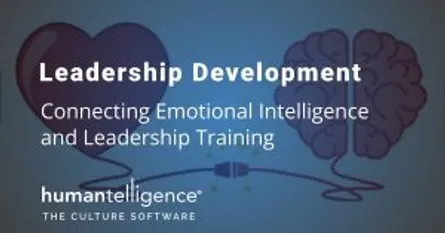
Improving emotional intelligence at work

Connecting Improving Emotional Intelligence at Work & Leadership Training
- 30 May, 2023
- Emotional Intelligence
It isn't surprising that the workplace can spark strong emotions in dedicated workers. Full-time employees spend at least 40 hours each week managing their workload, various personalities and other potential stress factors. To handle these stressors, organizations can focus on improving emotional intelligence at work for its leaders in order to help employees feel and perform better in the workplace. Many of today's employers understand the value of investing in their employees, seeking ways to help staff with high emotional intelligence/emotional quotient (EI/EQ) further develop those qualities. One way business leaders are working to draw out this talent is through improving emotional intelligence at work. Improving Emotional Intelligence at Work is Essential to the Human Experience It's critical that employers never forget the human element of "human" resources, and a full range of emotions is a part of a healthy human experience. The most common emotions include satisfaction, enthusiasm, comfort, fear, sadness and anger. However, it is important to understand, respect and abide by the fact that there is a time and place for different emotions. Even if employees feel a certain emotion, it is crucial that they know how to manage it and avoid letting it affect their co-workers or productivity. Certain emotions and emotional responses have no place at work. Emotions such as anger, for instance, are often counterproductive and sometimes dangerous in various senses. In a daily context, people who feel fueled by low-level anger can create a negative work environment that spreads quietly but assuredly. They might exhibit their anger through body language, subtle or not-so-subtle facial expressions, sarcasm, or other verbal expressions, whether under their breath, in writing or said outright for all to hear. It is essential that your leadership personnel in HR and management can detect the full spectrum of emotions to help tame or squash the distracting ones and identify and foster the productive ones. Strategies That Drive Emotional Intelligence and Leadership Development Employees who can help control emotional situations are incredible assets to today's business leaders. Instead of feeling helpless or watching an emotional scenario unfold, employees with strong EI can sometimes defuse situations quickly, effortlessly and in a way that leaves everyone feeling better about the outcome. These employees are also prime candidates for management and other leadership positions, making emotional quotient leadership skills an essential investment. The key is discovering the qualities in these employees through measurement and assessment. Once you find out who has good baseline EQ/EI levels, you can provide them with training to facilitate their growth. Employers have used various personality tests for decades, gleaning vital information about employees, managers and consultants. However, in many cases, these companies don’t dive deeper into the EQ/EI ramifications of the results. This is what modern advanced analytics software solutions and culture management tools from Humantelligence aim to do. By exploring the results on a deeper level, you can develop meaningful training opportunities for managers and other leaders in your organization. Even better, assessment measurements can provide invaluable information to help you design leadership courses and workshops that bring out the best in your strong EI/EQ candidates. Let's look at some ways to identify, foster and develop emotional intelligence and emotional quotient so you can maintain a harmonious and productive work environment for everyone:Find and reach out to employees who bear the hallmark characteristics of strong EQ/EI. Start by noting those employees who excel at identifying and naming emotions. These employees may also be able to apply appropriate emotions for problem-solving and tend to have a talent for regulating their emotions and knowing how to help regulate the feelings of others. Look for people with strong personal and social competence. You can't rely solely on high IQ and on-paper qualifications. It's essential to look at the social makeup of your job candidates and current employees. Provide emotional intelligence training for managers and general emotional intelligence workshops for all employees. Work to infuse emotional intelligence into your workplace culture. Humantelligence's Self-Assessment can help unlock your employees' true potential by measuring their behaviors, motivators and ideal work environment. Further, the Self-Assessment tool can help you better understand each employee's emotional intelligence and potential for improvement and leadership.When you take a closer look at your employees' personalities and EQ/EI levels, you can better understand their potential within your organization. Furthermore, doing so can help increase team communication, understanding, engagement and collaboration for your current employees.